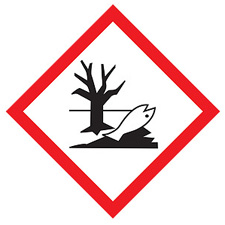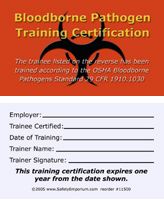



Find all of your laboratory and workplace safety supplies at Safety Emporium!
 Baumé Scale |
 Glossary Index |
 BOD |
| MSDS Topics |
Free Sites | FAQ's | Regulations | Glossary | Software | Suppliers |
| Books | Forum | Poll | Fun stuff | Quiz | Store | |
| Understand your MSDS with the MS-Demystifier | Search ALL our MSDS info | |||||

Get your GHS Enviroment labels and signs from Safety Emporium.
Biodegradable materials are generally plant-based (e.g. wood, vegetable oil), animal-based (e.g. manure) or natural mineral-based products (e.g. carbon fiber polymers). In general, materials derived from nature retain some of their original chemical properties which provides a mechanism for microbes to do their work. Biodegradable materials can be solids, biodegrading into the soil (which we also refer to as compostable), or they can be liquids, biodegrading into water.
Products such as plastics made from man-made petrochemical compounds (i.e. those obtained from petroleum or natural gas), generally do not biodegrade. Modern research has focused on developing biodegradable plastics that disintegrate due to the actions of microorganisms. This is being accomplished by incorporating starch molecules into the polymer as it is made. When these plastics are discarded, bacteria eat the starch molecules, the polymer molecules break apart, and the plastic decomposes.
Consider, for example, foam packing peanuts. Those made from polystyrene do not readily decompose. However, ones made from starch will actually degrade in water. You can usually tell the two apart because the starch ones are a bit sticky to the touch.

Make your PPE readily available with safety dispensers from Safety Emporium.
NOTE: We may collect a share of sales or other compensation from the links in the following list:
Section 12 of SDS's that conform to OSHA's implementation of the Globally Harmonized System (GHS) in the HCS 2012 regulation may list the environmental fate of the material and biodegradability. However, while SDS's are required to contain Sections 12 through 15, OSHA does not have the rulemaking authority to require manufacturers to provide content for those sections and they are deemed "non-mandatory". Therefore, Section 12 is blank on many SDS's although many conscientious SDS authors will provide whatever information they can.
Biodegradation may also be found on SDS's when discussing whether the material can be safely discharged to the environment or waterways.

Get your bloodborne pathogen safety materials from Safety Emporium.
See also: Biological oxygen demand, decomposition, RCRA, TRI.
Additional definitions from Google and OneLook.
Entry last updated: Friday, January 14, 2022. This page is copyright 2000-2025 by ILPI. Unauthorized duplication or posting on other web sites is expressly prohibited. Send suggestions, comments, and new entry desires (include the URL if applicable) to us by email.
Disclaimer: The information contained herein is believed to be true and accurate, however ILPI makes no guarantees concerning the veracity of any statement. Use of any information on this page is at the reader's own risk. ILPI strongly encourages the reader to consult the appropriate local, state and federal agencies concerning the matters discussed herein.